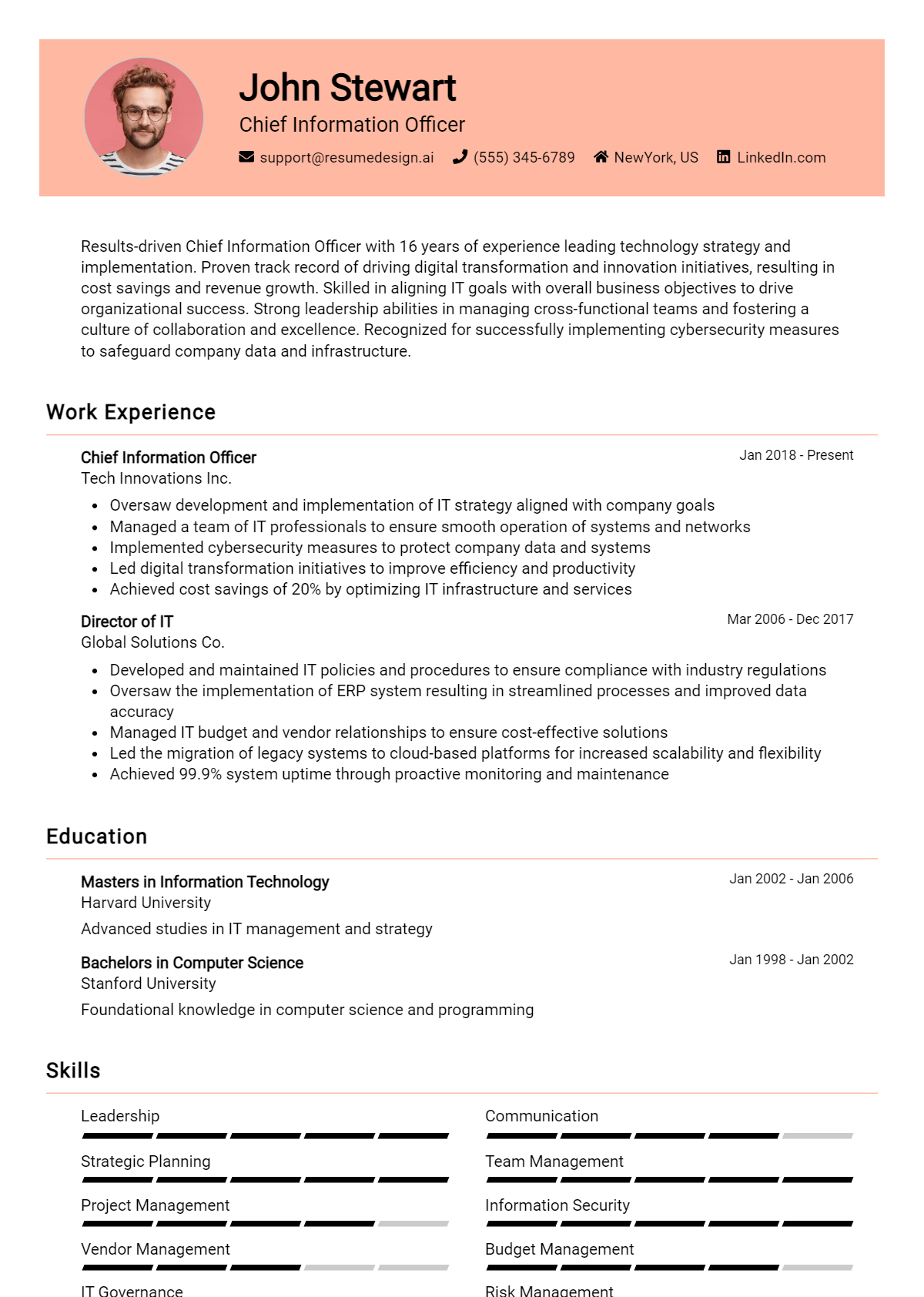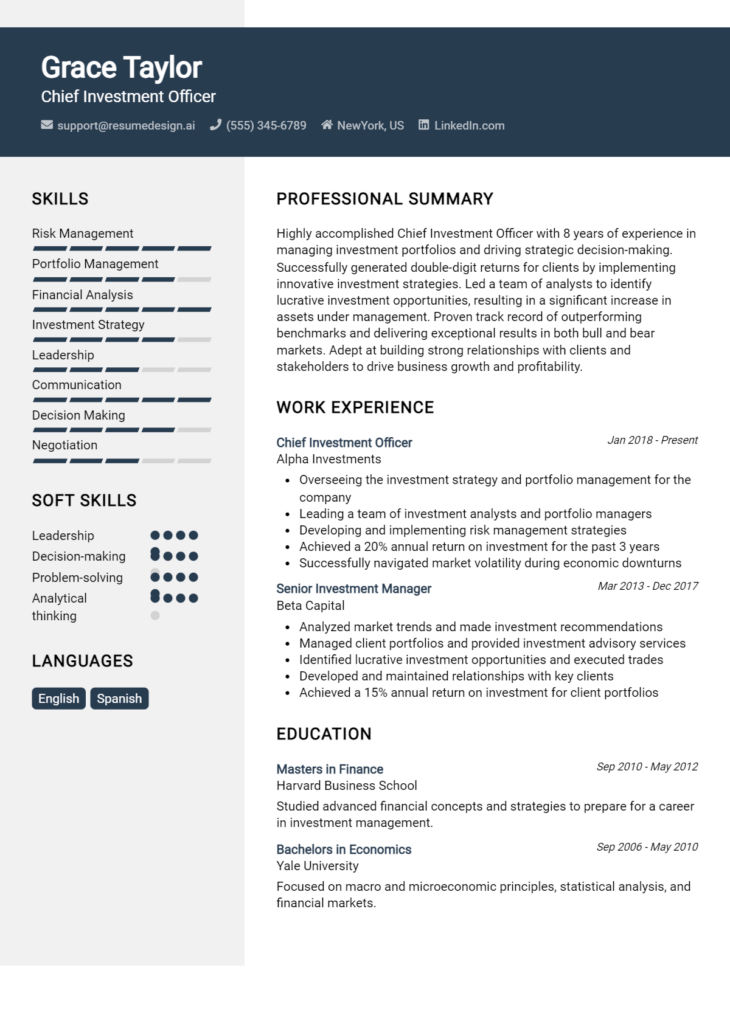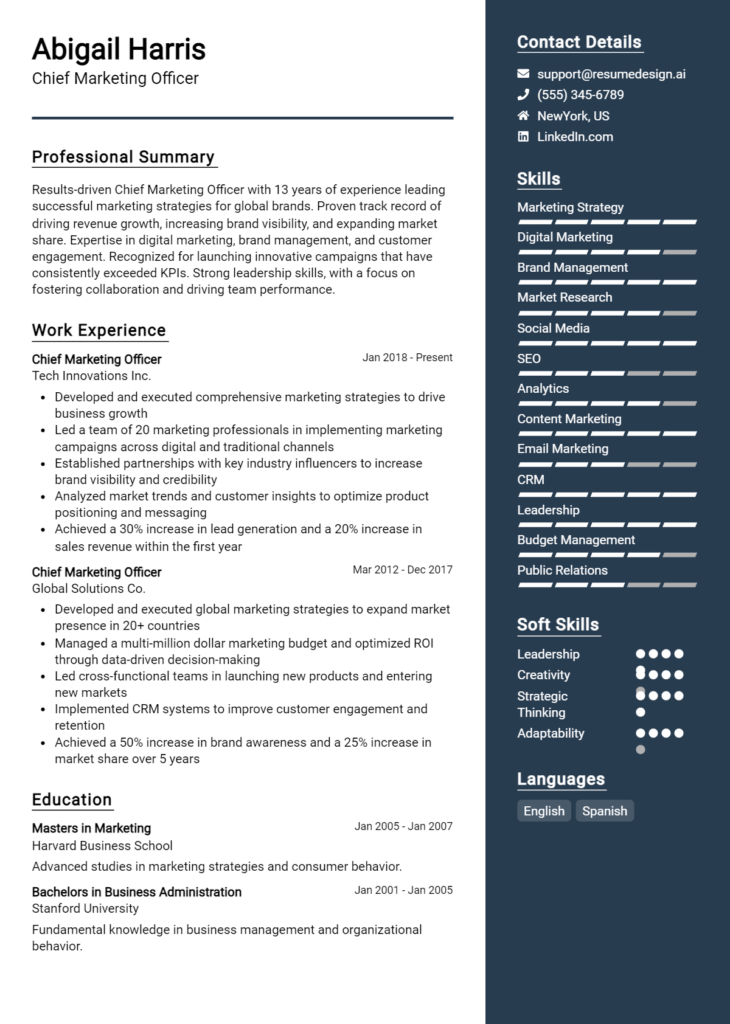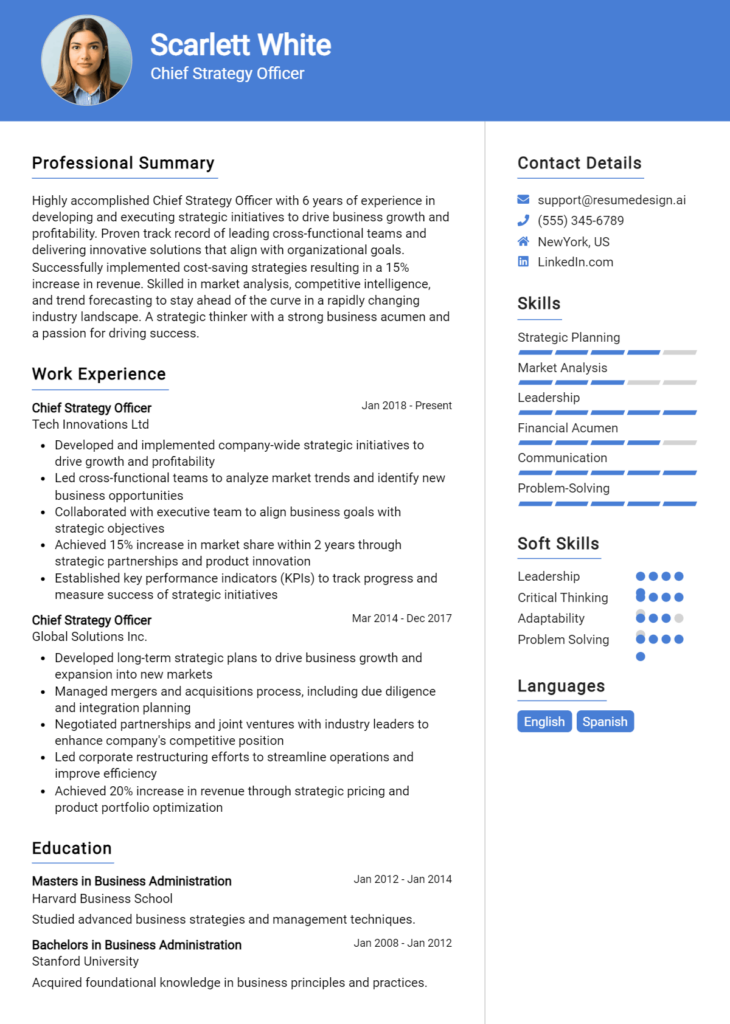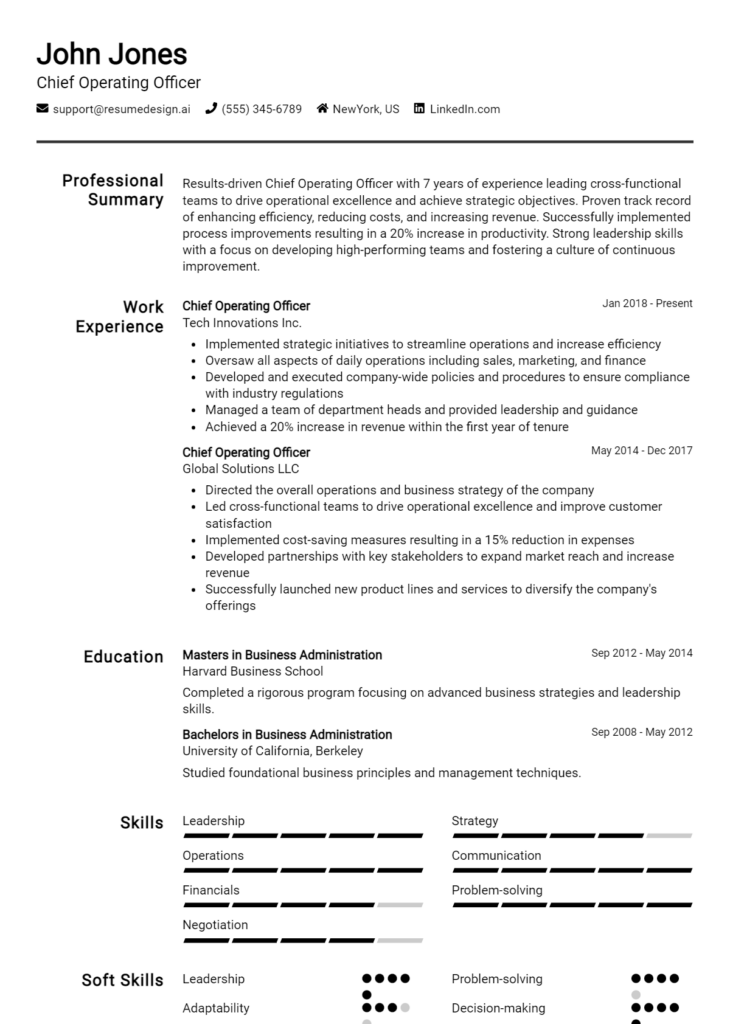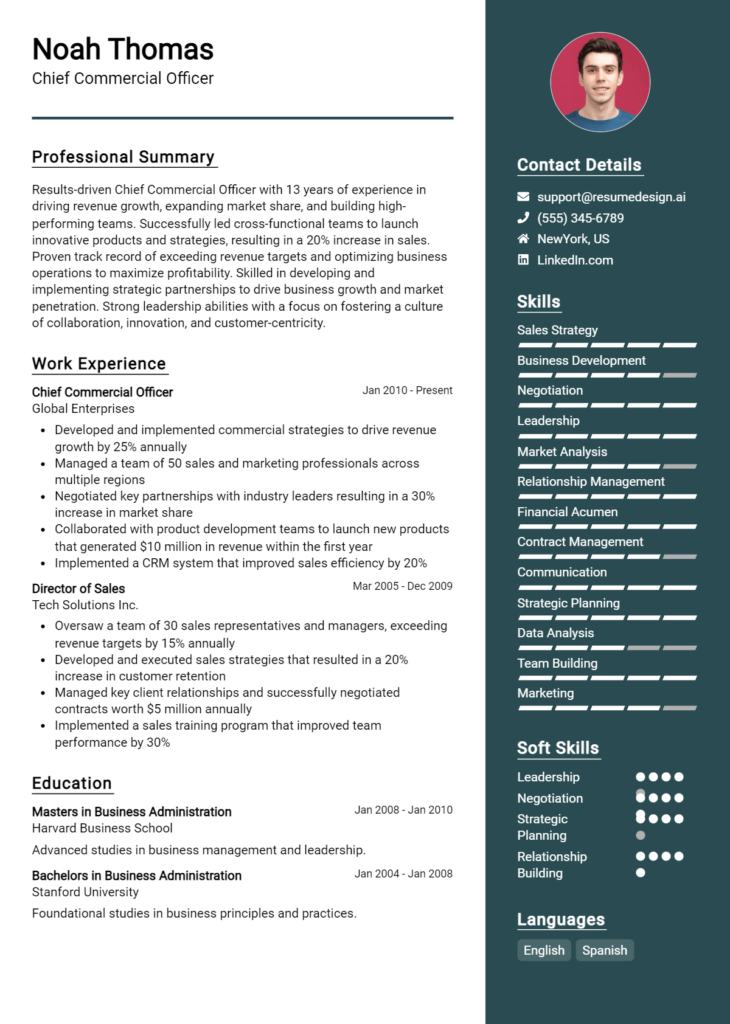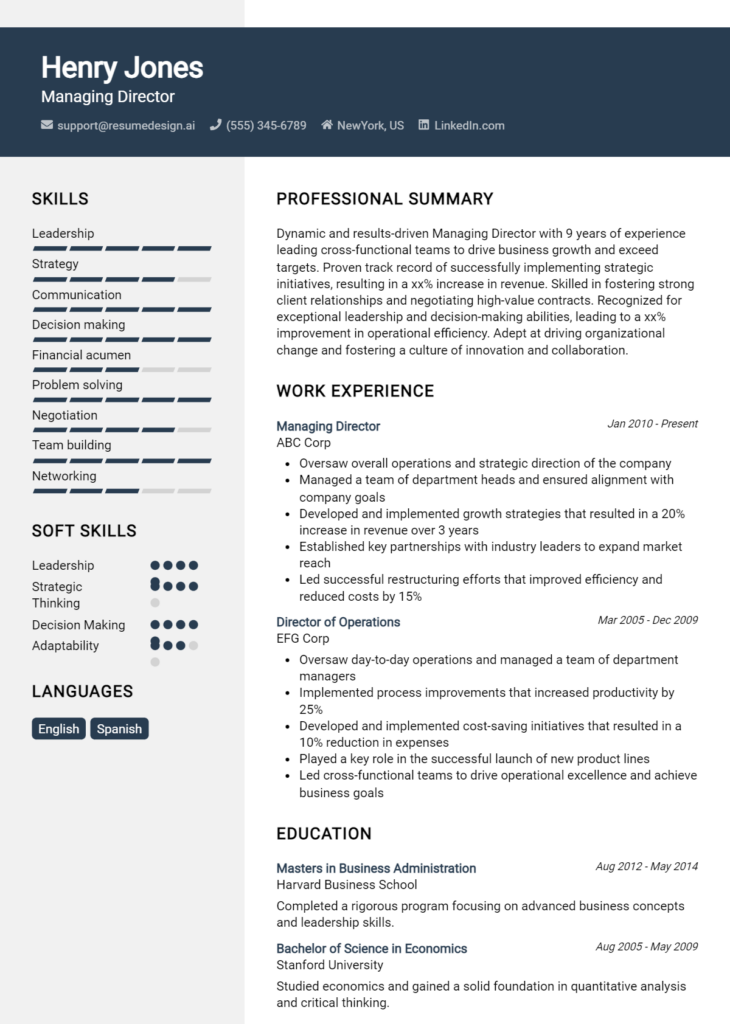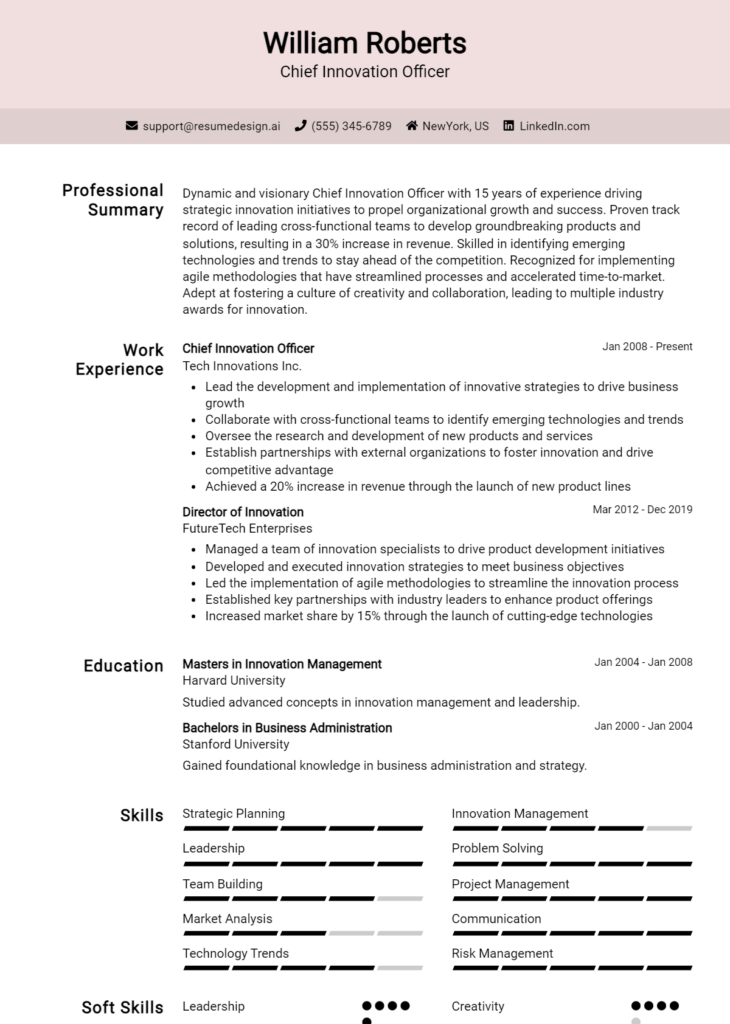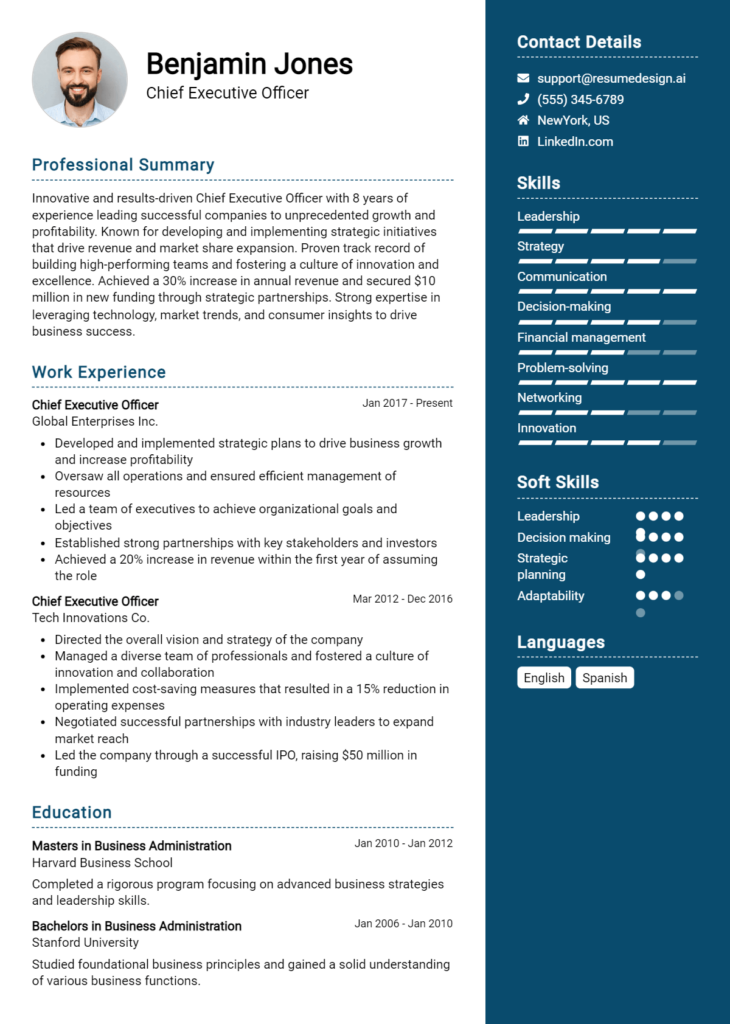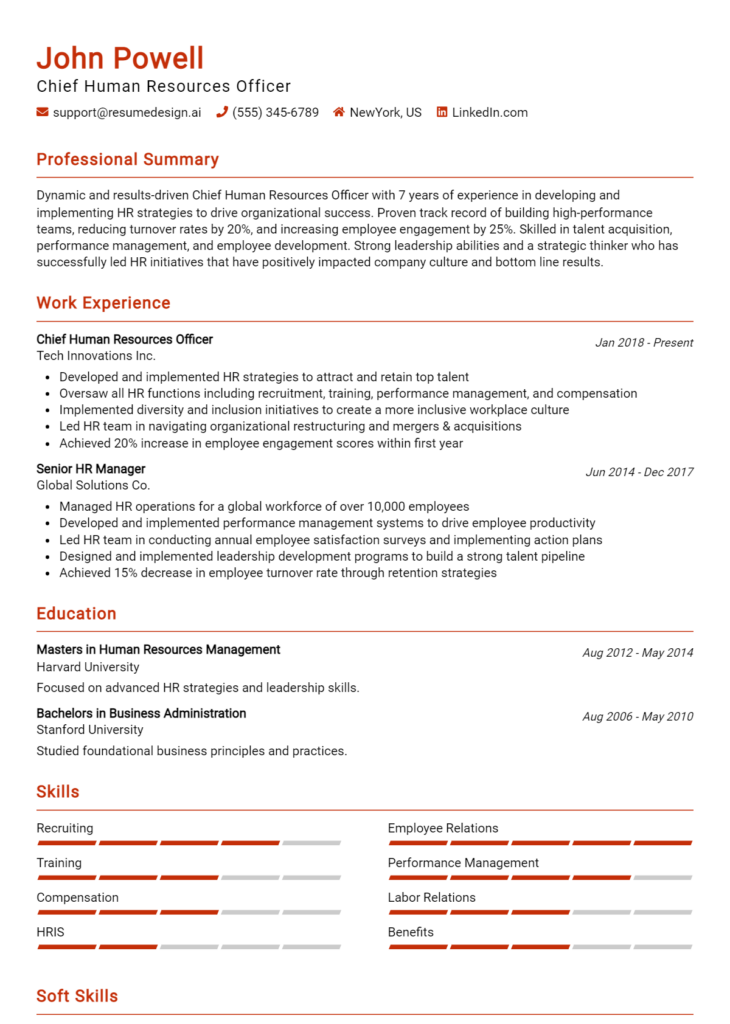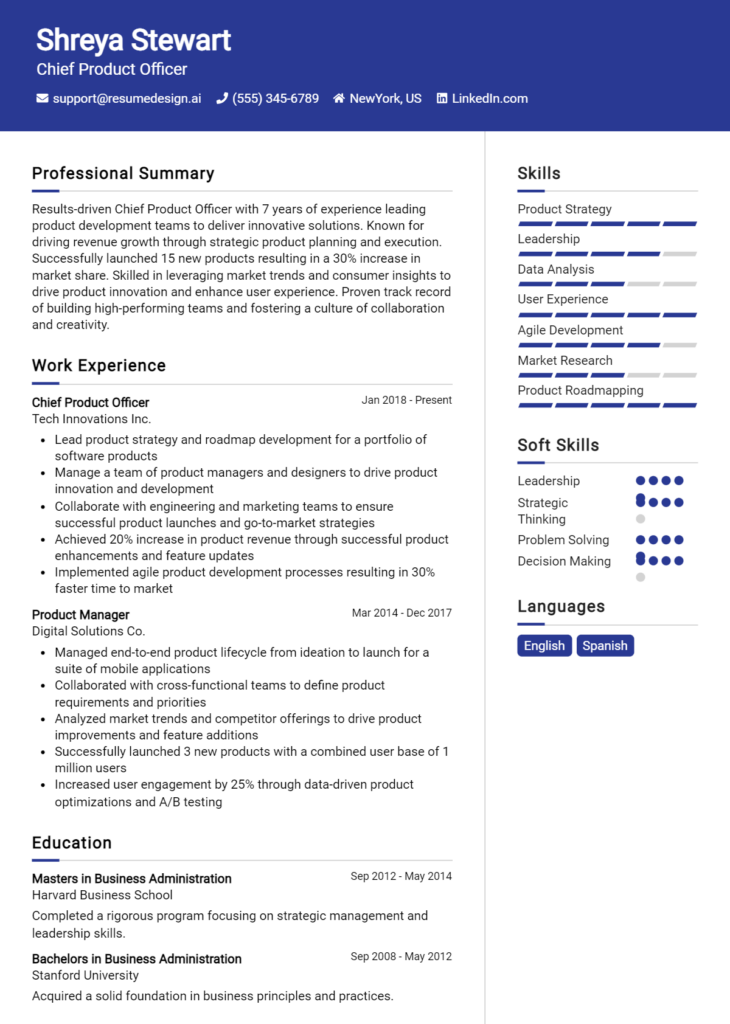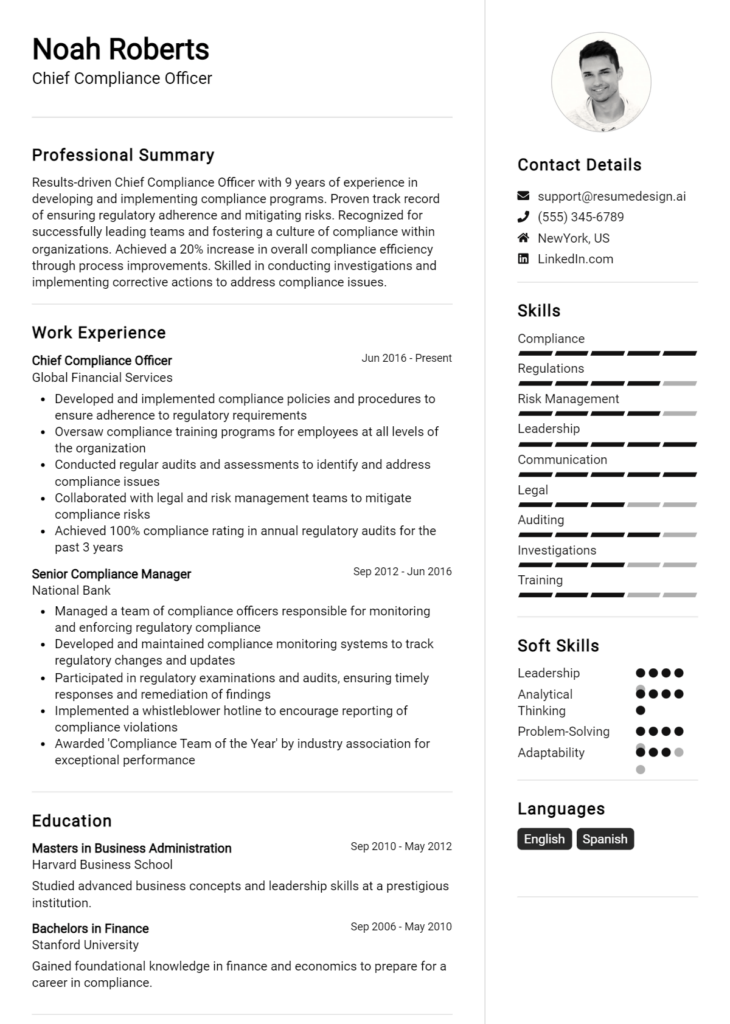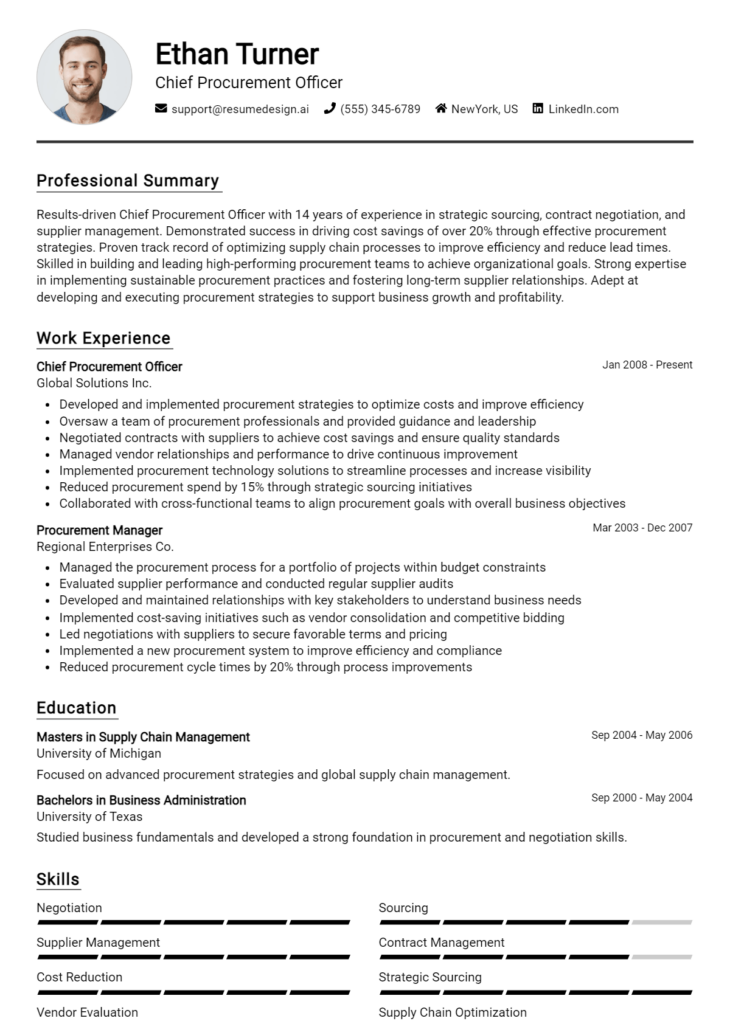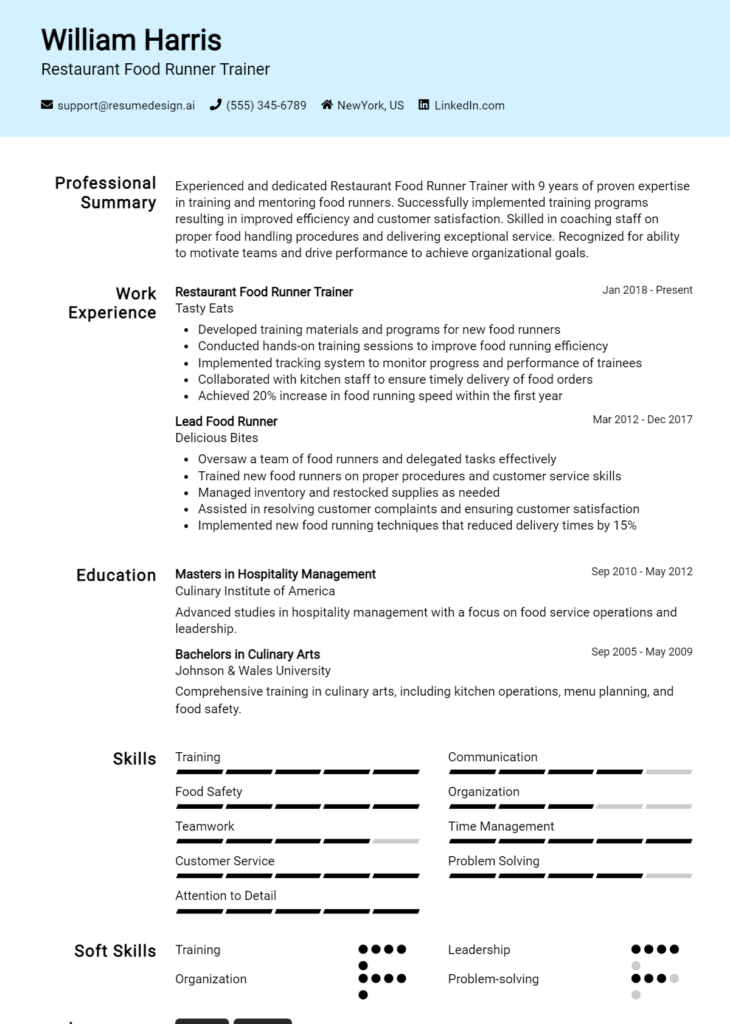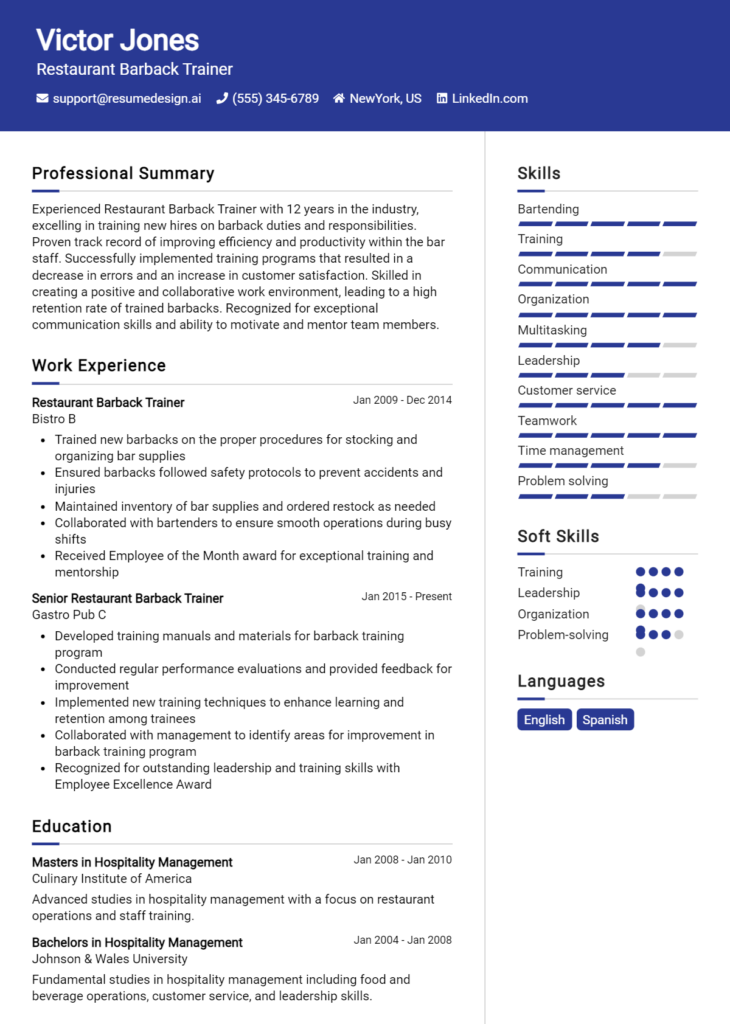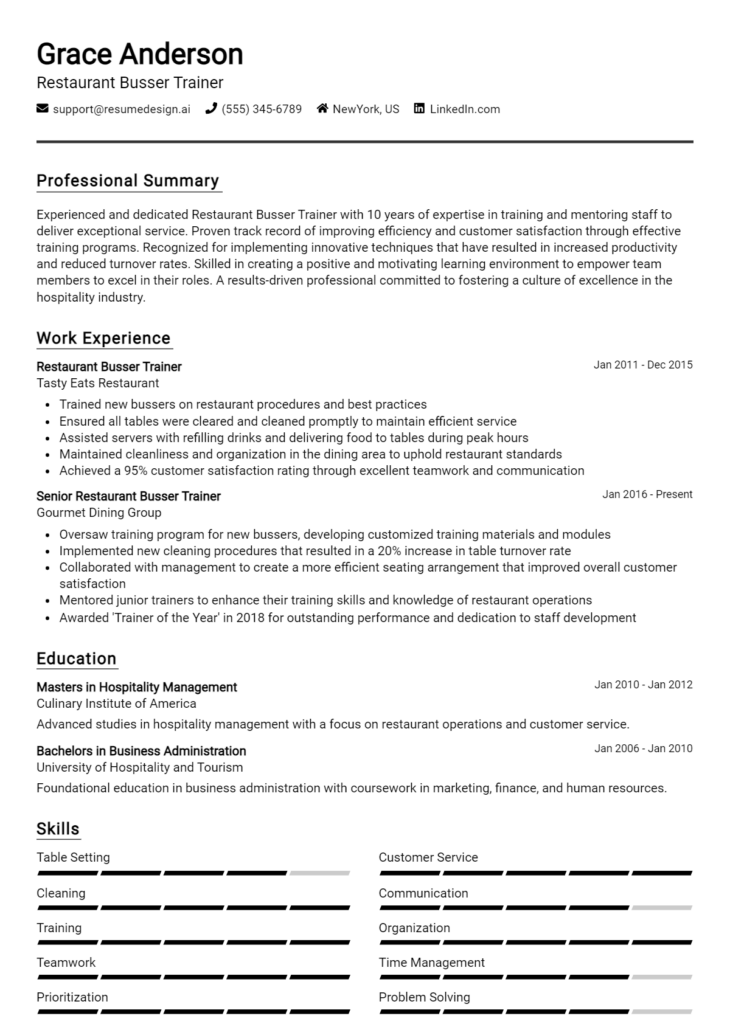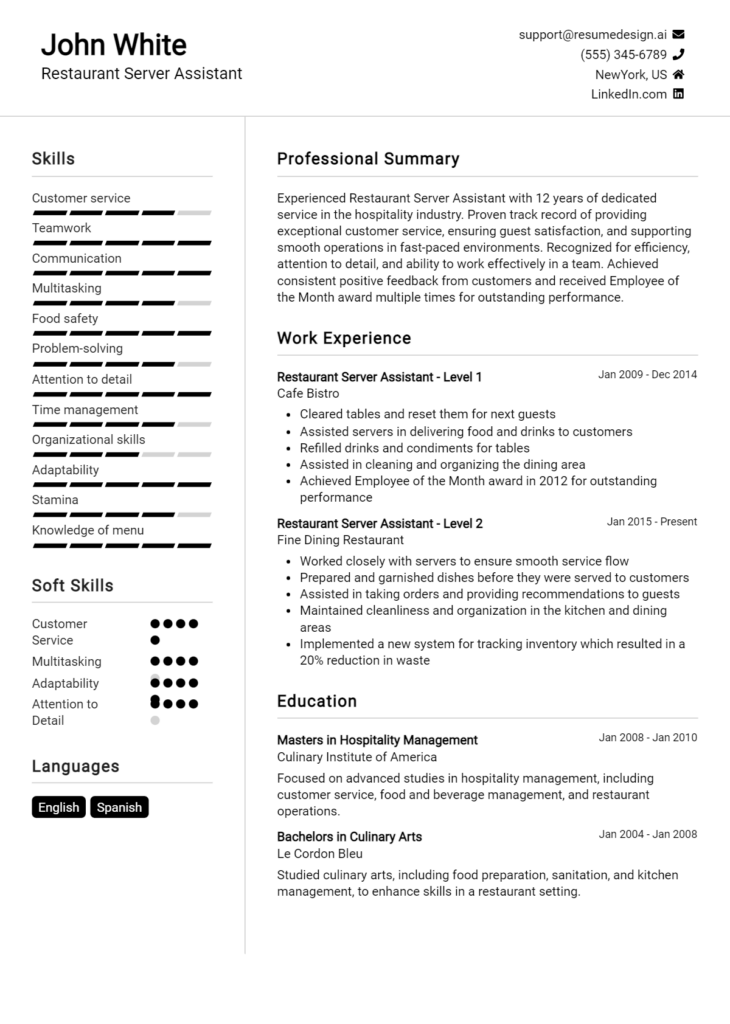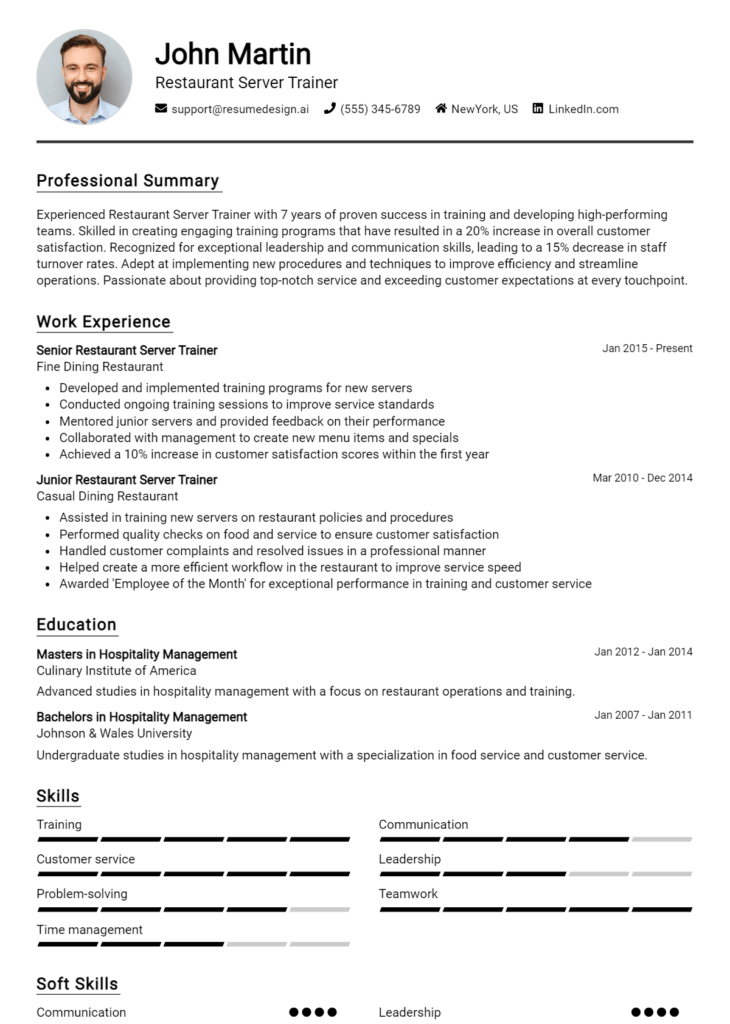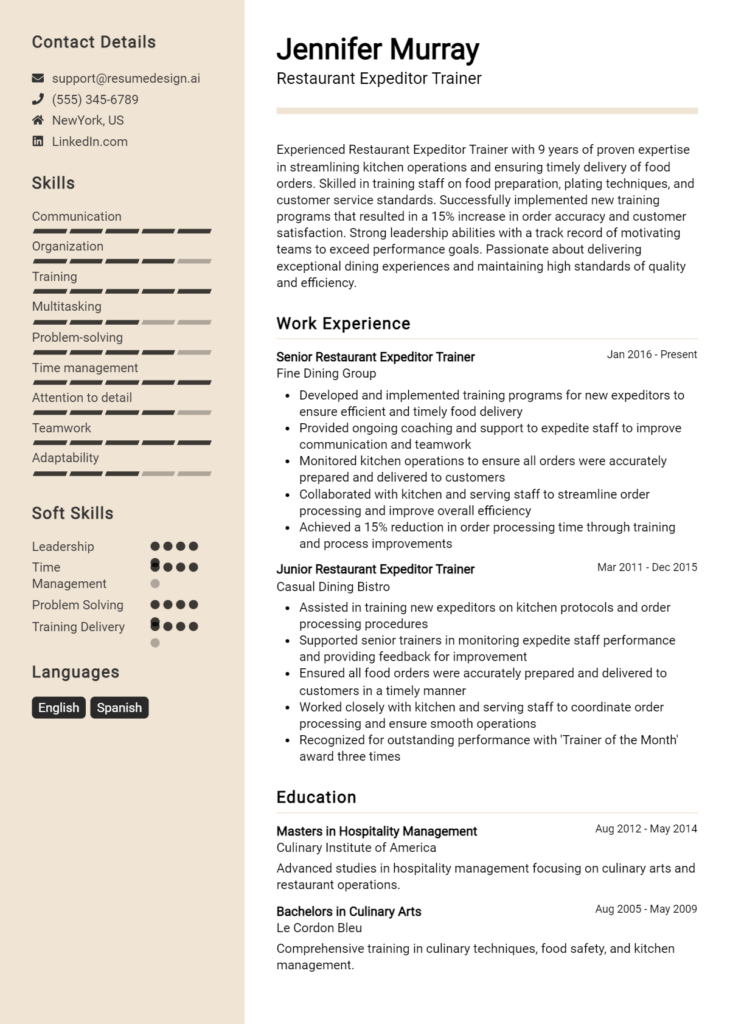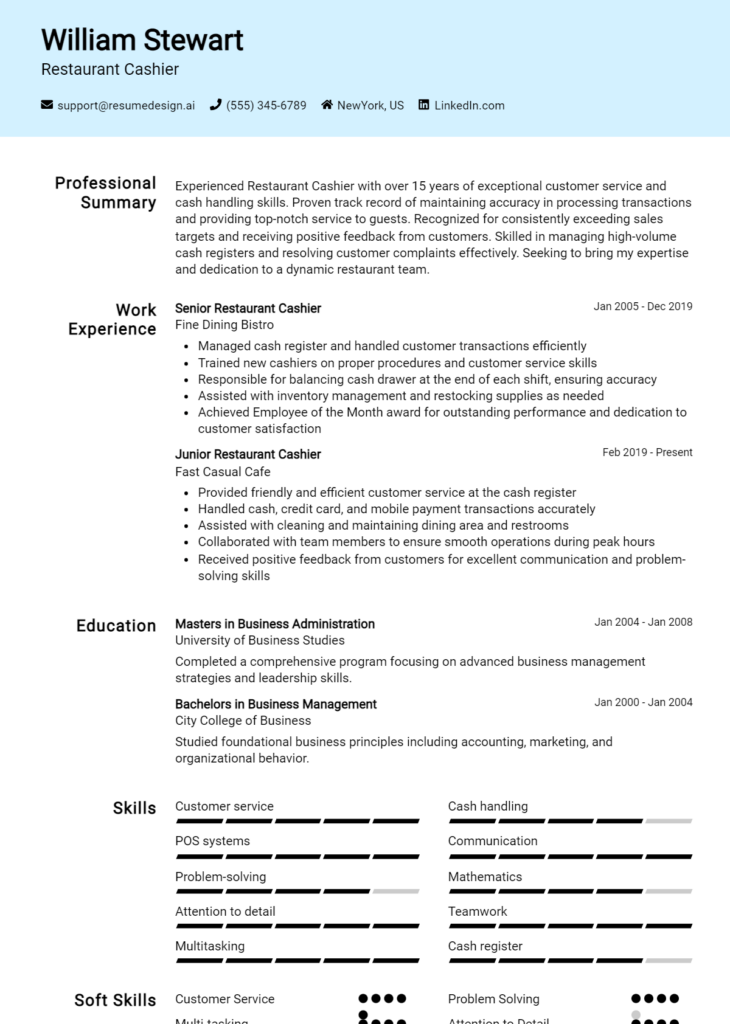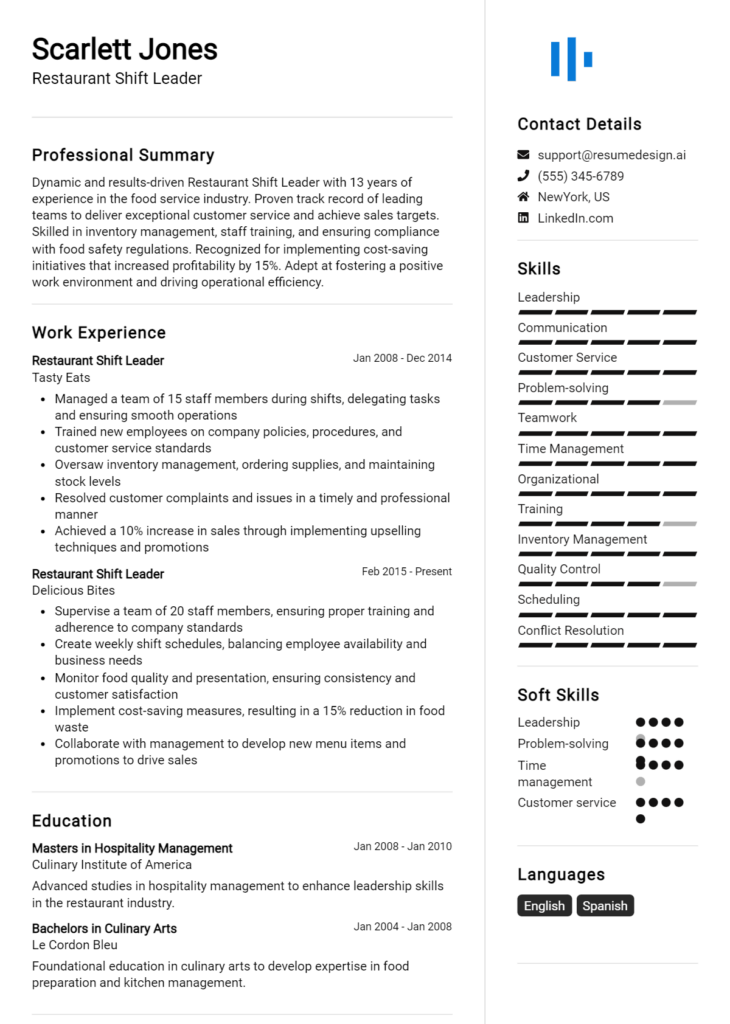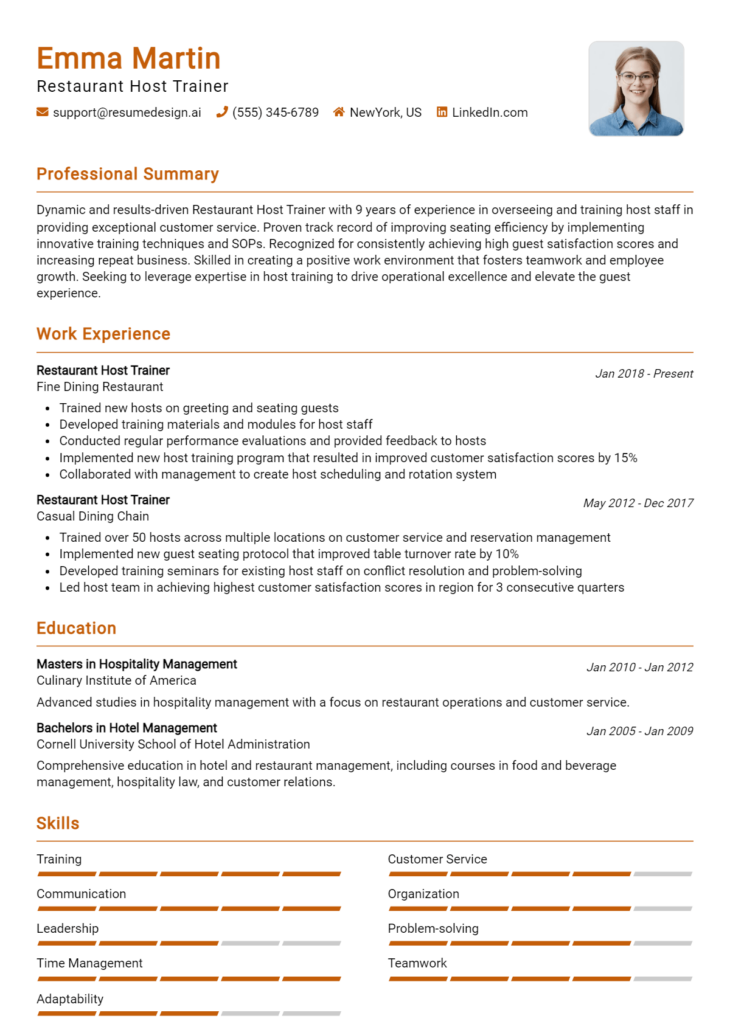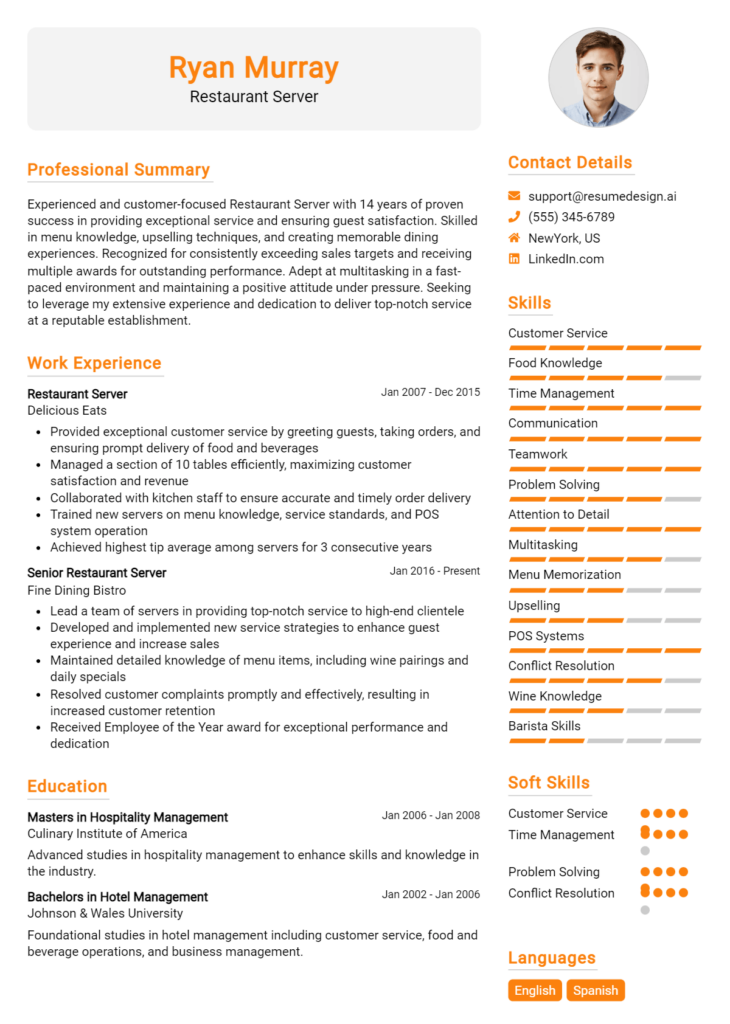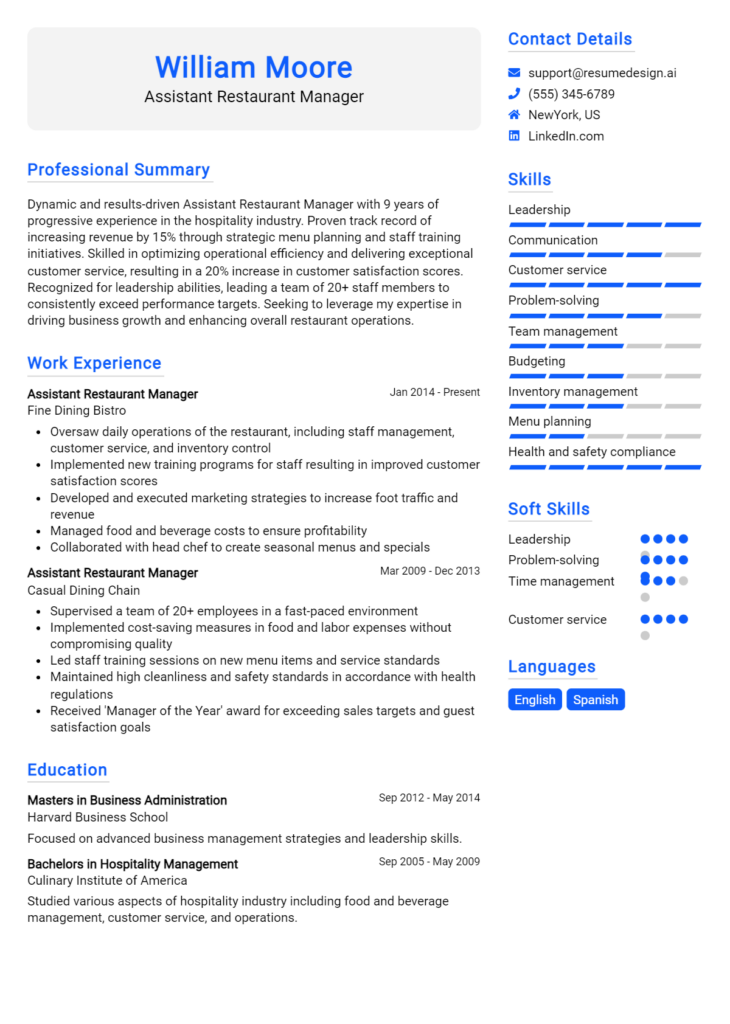Chief Information Officer Core Responsibilities
The Chief Information Officer (CIO) plays a crucial role in aligning technology with business strategies, effectively bridging different departments such as IT, finance, and operations. Key responsibilities include overseeing technology infrastructure, managing data security, and driving digital transformation initiatives. Essential skills encompass technical expertise, operational management, and problem-solving abilities, all of which contribute to achieving the organization's goals. A well-structured resume showcasing these qualifications can significantly enhance a CIO's career prospects.
Common Responsibilities Listed on Chief Information Officer Resume
- Developing and implementing IT strategy aligned with business goals.
- Overseeing the management of IT infrastructure and operations.
- Ensuring data security and compliance with regulations.
- Leading digital transformation projects across the organization.
- Managing IT budgets and resource allocation effectively.
- Collaborating with other departments to enhance technology utilization.
- Evaluating and implementing new technologies to improve business processes.
- Building and leading high-performing IT teams.
- Monitoring industry trends to maintain competitive advantage.
- Establishing IT governance frameworks and policies.
- Communicating technology strategies to stakeholders and executives.
High-Level Resume Tips for Chief Information Officer Professionals
In today's competitive job market, a well-crafted resume is crucial for Chief Information Officer (CIO) professionals seeking to make a lasting impression on potential employers. As the first point of contact between candidates and hiring organizations, the resume serves as a powerful marketing tool that must effectively showcase a candidate's skills, achievements, and strategic vision. A compelling CIO resume not only highlights technical expertise but also conveys leadership abilities and a deep understanding of how technology drives business outcomes. This guide will provide practical and actionable resume tips specifically tailored for Chief Information Officer professionals, ensuring that your application stands out in a crowded field.
Top Resume Tips for Chief Information Officer Professionals
- Tailor your resume to match the job description, emphasizing keywords and phrases that reflect the specific needs of the organization.
- Highlight relevant experience by showcasing previous roles that demonstrate your capability in strategic planning, project management, and IT governance.
- Quantify your achievements with metrics such as cost savings, revenue growth, or improvements in system efficiency to provide tangible evidence of your impact.
- Emphasize industry-specific skills, such as cybersecurity, cloud computing, data analytics, and digital transformation, to showcase your expertise in current technology trends.
- Include leadership experience that illustrates your ability to manage teams, influence organizational culture, and drive innovation.
- Utilize a clean and professional format, ensuring that your resume is easy to read and visually appealing, with clear headings and bullet points.
- Incorporate relevant certifications, such as ITIL, PMP, or CISSP, to further validate your qualifications and commitment to professional development.
- Showcase your understanding of business operations and how technology can align with organizational goals, demonstrating your strategic mindset.
- Keep your resume concise, ideally one to two pages in length, focusing on the most relevant and recent experiences that align with the CIO role.
By implementing these tips, you can significantly enhance your resume, making it a valuable asset in your job search. A well-structured and tailored resume will not only increase your visibility to recruiters but also improve your chances of landing interviews for top Chief Information Officer positions, paving the way for career advancement in this vital role.
Why Resume Headlines & Titles are Important for Chief Information Officer
In the competitive landscape of technology leadership, a Chief Information Officer (CIO) must stand out to capture the attention of hiring managers. Resume headlines and titles play a crucial role in this endeavor, as they serve as the first impression a candidate makes on potential employers. A well-crafted headline can immediately grab attention and succinctly summarize a candidate's key qualifications in a powerful phrase. It should be concise, relevant, and directly aligned with the specific job being pursued, making it easier for hiring managers to assess fit at a glance.
Best Practices for Crafting Resume Headlines for Chief Information Officer
- Keep it concise: Aim for a headline that is no more than 10-12 words.
- Be role-specific: Tailor your headline to reflect the specific CIO position you are applying for.
- Highlight key skills: Incorporate essential skills or experiences that are relevant to the CIO role.
- Use impactful language: Choose strong, action-oriented words to convey confidence and expertise.
- Avoid jargon: Ensure clarity by using straightforward language that can be easily understood.
- Focus on achievements: If possible, include quantifiable accomplishments that demonstrate your value.
- Reflect industry standards: Use terminology and phrasing commonly recognized in the tech and information management sectors.
- Update regularly: Revise your headline to align with changing job responsibilities and advancements in technology.
Example Resume Headlines for Chief Information Officer
Strong Resume Headlines
Transformational CIO Driving Digital Innovation and Strategic IT Alignment
Results-Oriented Chief Information Officer with Proven Track Record in Cost Optimization
Visionary IT Leader Specializing in Cybersecurity and Data Management
Weak Resume Headlines
Experienced Professional Seeking CIO Position
IT Expert Looking for New Opportunities
The strong resume headlines are effective because they are specific, impactful, and highlight key strengths that resonate with the CIO role. They convey a clear message about the candidate's qualifications and expertise, making them memorable. In contrast, the weak headlines fail to impress due to their vagueness and lack of distinctiveness. They do not provide any specific information about the candidate's skills or achievements, making it difficult for hiring managers to see the value they could bring to the organization.
Writing an Exceptional Chief Information Officer Resume Summary
A resume summary is a critical component for a Chief Information Officer (CIO) as it serves as a powerful introduction that quickly captures the attention of hiring managers. This brief paragraph is an opportunity to showcase key skills, relevant experience, and notable accomplishments that align with the demands of the job. A well-crafted summary should be concise, impactful, and tailored specifically to the position being applied for, making it easier for hiring professionals to recognize the candidate's value at a glance.
Best Practices for Writing a Chief Information Officer Resume Summary
- Quantify Achievements: Use numbers and metrics to highlight the impact of your work, such as cost savings or revenue growth.
- Focus on Key Skills: Emphasize technical skills, leadership abilities, and strategic thinking relevant to the CIO role.
- Tailor for the Job Description: Customize your summary to reflect the specific requirements and responsibilities outlined in the job posting.
- Highlight Industry Experience: Mention your background in the industry, particularly if you have experience in sectors relevant to the potential employer.
- Showcase Leadership Qualities: Include examples of how you've led teams, managed projects, or driven innovation within your organization.
- Use Action-Oriented Language: Start with strong action verbs to convey a sense of proactivity and effectiveness.
- Keep It Concise: Aim for 3-4 sentences that pack a punch without overwhelming the reader.
- Include Relevant Certifications/Qualifications: Mention any advanced degrees or certifications that bolster your credibility as a CIO.
Example Chief Information Officer Resume Summaries
Strong Resume Summaries
Dynamic CIO with over 15 years of experience leading IT transformations in Fortune 500 companies, achieving a 30% reduction in operational costs while improving service delivery by 40%. Proven track record in driving digital innovation and implementing cloud-based solutions that enhance organizational efficiency.
Results-oriented Chief Information Officer specializing in cybersecurity and data governance, successfully reducing security incidents by 60% through strategic initiatives. Expert in aligning IT strategy with business goals to drive growth, reflected in a 25% increase in revenue over three years.
Innovative CIO with a decade of experience in leveraging technology to improve customer engagement, resulting in a 50% increase in user satisfaction scores. Skilled in leading cross-functional teams to develop and implement enterprise-wide digital strategies.
Weak Resume Summaries
Experienced IT professional looking for a CIO position. I have worked in various roles and have some knowledge of technology.
Chief Information Officer with experience in managing technology. I am dedicated and hard-working, seeking opportunities to improve an organization’s IT framework.
The examples provided above illustrate the stark contrast between strong and weak resume summaries. The strong summaries are specific and quantifiable, showcasing achievements and skills that directly relate to the CIO role. In contrast, the weak summaries are vague and lack measurable outcomes, failing to convey the candidate's true capabilities or relevance to the position.
Work Experience Section for Chief Information Officer Resume
The work experience section of a Chief Information Officer (CIO) resume is a critical component that demonstrates the candidate's technical proficiency, leadership capabilities, and success in delivering high-quality products and services. This section not only highlights the candidate's ability to manage teams and drive strategic initiatives but also offers a platform to quantify achievements, making the case for their impact on organizational success. By aligning their experience with industry standards and showcasing measurable results, candidates can effectively communicate their value to potential employers in a competitive landscape.
Best Practices for Chief Information Officer Work Experience
- Focus on quantifiable achievements, such as revenue growth, cost savings, or project completion rates.
- Detail specific technical skills and tools used in previous roles to highlight expertise.
- Emphasize leadership experiences and team management to showcase collaboration abilities.
- Use action verbs to convey a proactive approach in driving initiatives and results.
- Align experiences with industry best practices and standards to demonstrate relevance.
- Incorporate keywords from the job description to tailor the resume for specific positions.
- Highlight cross-functional collaboration with other departments to showcase teamwork.
- Include professional development opportunities undertaken, such as certifications or training relevant to the role.
Example Work Experiences for Chief Information Officer
Strong Experiences
- Led a team of 50 IT professionals to implement a new cloud-based infrastructure, resulting in a 30% reduction in operational costs over two years.
- Directed a cybersecurity initiative that increased threat detection capabilities by 40%, significantly reducing data breach incidents.
- Managed the deployment of an enterprise resource planning (ERP) system that improved process efficiency by 25% and enhanced reporting accuracy.
- Collaborated with cross-functional teams to launch a mobile application that achieved over 100,000 downloads in the first six months, boosting customer engagement by 50%.
Weak Experiences
- Responsible for overseeing IT operations.
- Worked on various technology projects.
- Managed a team of IT staff.
- Involved in some software development initiatives.
The examples of strong experiences illustrate concrete achievements, measurable outcomes, and effective leadership, which are essential for a CIO role. They highlight specific contributions and demonstrate the candidate's ability to drive significant improvements within an organization. Conversely, the weak experiences lack detail and quantifiable results, making them less impactful and failing to convey the candidate's true capabilities or contributions. This contrast emphasizes the importance of specificity and measurable success in a CIO's work experience section.
Education and Certifications Section for Chief Information Officer Resume
The education and certifications section of a Chief Information Officer (CIO) resume is crucial for showcasing a candidate's academic background and commitment to ongoing professional development. This section not only highlights formal education but also emphasizes industry-relevant certifications and specialized training that can significantly enhance the candidate's credibility. By providing details on relevant coursework and advanced credentials, candidates can demonstrate their alignment with the demands of the CIO role, showcasing their knowledge and skills necessary to navigate the complexities of technology management and strategic decision-making.
Best Practices for Chief Information Officer Education and Certifications
- Prioritize relevant degrees such as Computer Science, Information Technology, or Business Administration.
- Include advanced certifications like Certified Information Systems Security Professional (CISSP) or Project Management Professional (PMP).
- Detail any specialized training in emerging technologies that align with the organization's needs.
- Highlight coursework that demonstrates leadership, strategic planning, or IT governance.
- Ensure certifications are current and reflect ongoing professional development.
- Use clear and concise formatting to enhance readability and emphasize key qualifications.
- Explain the relevance of each certification or degree to the CIO role to strengthen your narrative.
- Consider including a brief summary of academic achievements or honors if applicable.
Example Education and Certifications for Chief Information Officer
Strong Examples
- MBA in Information Technology Management, Harvard Business School, 2015
- Certified Information Systems Security Professional (CISSP), 2020
- Master’s Certificate in IT Project Management, George Washington University, 2018
- Relevant Coursework: Strategic IT Management, Cybersecurity Frameworks, and Data Analytics
Weak Examples
- Bachelor’s in General Studies, State University, 2005
- Certification in Basic Computer Skills, 2010
- Online Course in Social Media Marketing, 2019
- High School Diploma, 2000
The examples categorized as strong demonstrate a clear alignment with the responsibilities and skills required for a Chief Information Officer, showcasing advanced degrees and relevant certifications that indicate a high level of expertise. In contrast, the weak examples reflect outdated or unrelated qualifications that fail to add value to the CIO role, highlighting the importance of relevance and specificity in this critical section of the resume.
Top Skills & Keywords for Chief Information Officer Resume
As a Chief Information Officer (CIO), the integration of technology and business strategy is paramount, making a well-crafted resume essential for showcasing the right skills. The skills highlighted in a CIO's resume not only reflect their ability to manage IT operations but also their proficiency in aligning technology with organizational goals. These skills communicate to potential employers that the candidate can navigate complex environments, lead innovation, and drive digital transformation. Emphasizing both hard and soft skills is crucial, as they collectively demonstrate the candidate's comprehensive capability to fulfill the demanding role of a CIO.
Top Hard & Soft Skills for Chief Information Officer
Soft Skills
- Leadership
- Strategic Thinking
- Communication
- Problem Solving
- Change Management
- Collaboration
- Decision Making
- Adaptability
- Negotiation
- Emotional Intelligence
- Time Management
- Conflict Resolution
- Team Building
- Stakeholder Engagement
- Visionary Thinking
Hard Skills
- IT Strategy Development
- Cybersecurity Management
- Data Analytics
- Cloud Computing
- IT Governance and Compliance
- Project Management
- Enterprise Architecture
- Budget Management
- Software Development Lifecycle (SDLC)
- Vendor Management
- Network Infrastructure Management
- Business Process Improvement
- Digital Transformation
- Risk Management
- Systems Integration
- Emerging Technologies
- Artificial Intelligence and Machine Learning
For a comprehensive guide on how to highlight these skills effectively, along with structuring your work experience, consider tailoring your resume to align with these competencies that are critical for a successful CIO.
Stand Out with a Winning Chief Information Officer Cover Letter
Dear [Hiring Manager's Name],
I am writing to express my interest in the Chief Information Officer position at [Company Name], as advertised on [where you found the job posting]. With over [number] years of experience in information technology and a proven track record of driving digital transformation, I am confident in my ability to contribute effectively to your organization’s strategic vision. My extensive background in developing innovative IT solutions and leading high-performing teams aligns perfectly with the goals of [Company Name].
In my previous role as [Your Most Recent Job Title] at [Your Most Recent Company], I successfully led a comprehensive IT overhaul that improved operational efficiency by [specific percentage or metric]. By fostering a culture of collaboration and continuous improvement, I guided cross-functional teams in implementing cutting-edge technologies, such as cloud computing and data analytics, which resulted in a significant reduction in costs and enhanced decision-making capabilities. My leadership style emphasizes empowering team members and leveraging their strengths, which I believe is vital to achieving organizational objectives.
I am particularly drawn to [Company Name] because of its commitment to innovation and customer-centric solutions. I am excited about the possibility of contributing to your mission of [specific mission or initiative of the company], and I am eager to bring my expertise in cybersecurity, enterprise architecture, and strategic IT planning to the table. I am confident that my proactive approach and strong analytical skills will help [Company Name] navigate the complexities of today’s digital landscape and drive sustainable growth.
Thank you for considering my application. I look forward to the opportunity to discuss how my experience and vision align with the future goals of [Company Name]. I am excited about the prospect of collaborating with your team to leverage technology in driving business success.
Sincerely,
[Your Name]
[Your Contact Information]
[LinkedIn Profile or Website, if applicable]
Common Mistakes to Avoid in a Chief Information Officer Resume
Crafting a compelling resume for the Chief Information Officer (CIO) position requires careful attention to detail, as this role demands a unique blend of technical expertise, leadership capabilities, and strategic vision. Many candidates make common mistakes that can hinder their chances of landing an interview. Avoiding these pitfalls can significantly enhance the effectiveness of your resume and present you as a strong contender. Here are some common mistakes to be mindful of:
Vague Job Descriptions: Failing to provide specific details about previous roles can leave hiring managers uncertain about your capabilities. Use quantifiable achievements and clear responsibilities to showcase your impact.
Neglecting Leadership Experience: CIOs are expected to lead teams and drive technology initiatives. Omitting leadership roles or achievements can diminish your qualifications. Highlight your experience in managing teams and projects effectively.
Overloading with Technical Jargon: While technical skills are essential, using excessive jargon can alienate those who may not share your background. Balance technical details with clear, accessible language to ensure readability.
Ignoring Soft Skills: The CIO role requires strong interpersonal skills and strategic thinking. Not mentioning these attributes can create an incomplete picture of your qualifications. Be sure to incorporate examples of collaboration, communication, and problem-solving.
Lack of Tailoring: Sending out a generic resume can weaken your application. Tailor your resume to reflect the specific requirements and culture of the organization you’re applying to, demonstrating your genuine interest and fit.
Inconsistent Formatting: A cluttered or inconsistent layout can distract from your content. Maintain a clean, professional format with uniform fonts and clear headings to enhance readability.
Failing to Highlight Industry Trends: The technology landscape is constantly evolving, and CIOs must stay ahead. Not mentioning your knowledge of current industry trends or innovations can make your application seem outdated.
Missing Metrics and Results: CIOs are often evaluated based on the impact of their initiatives. Failing to include metrics or outcomes from your previous projects can result in a lack of evidence to support your achievements. Be sure to quantify your success whenever possible.

